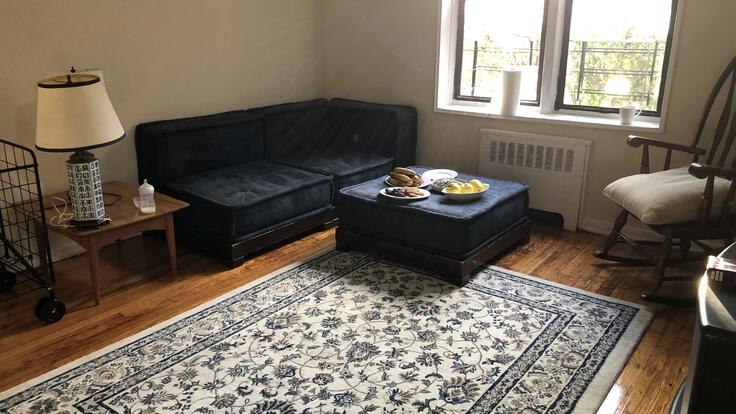
Finding Housing in NYC is one of the most stressful processes of settling in NYC – whether renting a truck to move in furniture or going online to find a roommate, it's important to be resourceful in New York City. Being resourceful, however, without resources or access to a wide network of support is daunting.
Last year, the IRC in NY supported more than 2,500 recently arrived refugees, immigrants, and asylees. Compared to 2021, which saw most clients arriving in the fall, the IRC in NY saw many clients arriving year-round in 2022. Housing is one of the many crisis response services that supported all refugees including Afghan and Ukrainian evacuees.
The IRC in NY Housing & Logistics team, which sits in the Resettlement & Placement department, was geared up to make the already complex housing process more comprehensive. This was especially key in the face of market inflation and competition which was worsened by the pandemic and ultimately led to limited housing access and financial insecurity.
In 2022, the IRC in NY Housing & Logistics team assisted over 150 clients with temporary housing assistance to permanent housing searches, moves, and furnishings. Clients were arriving from Afghanistan, Ukraine, Guatemala, Honduras, Sudan, Burma, Venezuela, China, and more countries. Many clients moved to Queens and Brooklyn, which are popular neighborhoods for migrating communities especially given their diverse social fabric and lower living costs.
There are a number of routes clients take in their search for permanent housing. It can be overwhelming to understand where to begin regardless if one previously lived in a city. Clients could either secure their own housing, live with their “US Tie” (a relative that lives in the local area), or get assistance in securing a home. There are a lot of factors, barriers, and pathways that inform a client’s decision on a home. The IRC in NY works closely with clients to help them identify their housing needs in order to feel safe and protected.
The Housing & Logistics team assists clients with evaluating through many considerations, such as:
- Neighborhood: access to culturally relevant food and community,
- Education Opportunities: Quality of a neighboring school,
- Commuting: Price of public transportation and proximity to central subway stations,
- How close a home is to work or a potential job location,
- How close a home is to their US TIE: family member or friend,
- Price and Housing terms
From one expectation or consideration to another, making the right decision requires patience both in waiting for a vacant home and making the decision to move in.
On top of this, for many migrants who just began early employment or awaiting their Employment Authorization Card (EAD), paying for housing with at least two months secured is difficult to manage. In 2020, 45% of non-U.S. citizens living in NYC earned incomes below or near the federal poverty level, compared to 34% of native-born citizens. For many migrants recovering from the pandemic or arriving here during the post-pandemic, there is a shared sense of financial distress. With high levels of poverty, this financial gap made housing affordability frayed. For many migrants recovering from the pandemic or arriving here during the post-pandemic, there is a shared sense of financial distress. With high levels of poverty, this financial gap made housing affordability frayed.
In 2022, access to affordable housing dwindled. Clients were critically affected by high rental prices. Just in 2021: “the average rent in Manhattan rose to $5,058 in June, up from $4,975 in May and $3,922 in June 2021.” It is an understandable shock to learn how rent and utilities are priced. In 2021, 1.69 of 8.47 million New York City residents received SNAP benefits to help purchase food. This goes to show the tremendous level of food insecurity that communities continue to face in the city. For refugees and immigrants, food insecurity was greatly felt for those living in temporary housing where access to a kitchen and food became limited and outside one’s agency. Many families shared how access to public benefits and housing support is crucial for their stability.
As a client-facing support service, the IRC in NY’s Housing & Logistics team believes that advocating for clients is an integral part of their housing search. That includes negotiating with landlords to find affordable rent options and payment adjustments or working with partners from the city or upstate to secure furniture and other basic needs including food and household items.
Staying in temporary housing, while a helpful solution, still compromised clients’ sense of safety. The difficult reality of 2022 was that many clients had to live in temporary housing for more than one month and some for nearly 3 months because they couldn’t find a home. This was especially the case for Afghan families. In this process, the IRC in NY saw an increase in mental health needs, with many clients affected by stress-induced trauma worsened by prolonged instability. Sometimes a client was stressed living in their temporary stay to the point that they decided to move into their first available option. This often resulted in a client requesting to change their housing to move to a different neighborhood/borough or a bigger apartment if their family was growing.
The IRC in NY Housing & Logistics team is still trying to find homes for clients who arrived in December and are staying in temporary housing. At the moment, there is a family of 9 still looking for a home which may even need to split up to find homes closer together. These are the many scenarios and challenges that marked 2022.
Despite these challenges, in each phase of securing permanent housing, the Resettlement & Placement and Housing & Logistics team at IRC in NY always prioritize the client. All of these efforts contribute to ensuring a housing option is safe and financially attainable for the client and their family.